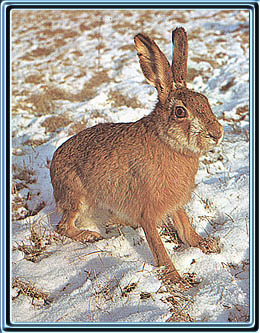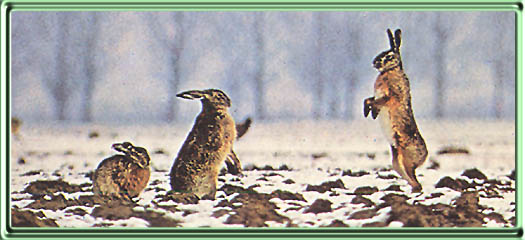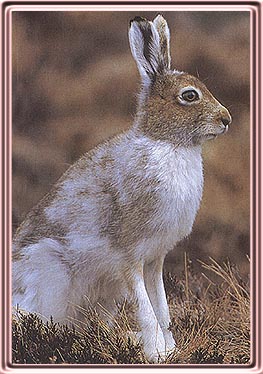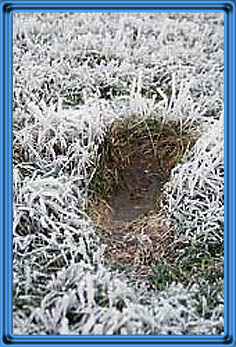
Lepus capensis
The Brown Hare
The mad hares of March are the males, which bound, kick and stand on their back legs to box with each other in a ritual that impresses the females before mating. At such times they seem oblivious to danger and can easily be approached.

Size: The does can be just over 2 feet long and slightly larger than the males.
Appearance: The brown hare is tawny coloured with the upper parts a mixture of brown and grey hairs and the flanks and underside paler. The ears have black tips.
Diet: Brown hares feed mainly on herbs in the summer, and predominantly grasses in the winter. They also feed on cereal and root crops, and in bad seasons, it has been suggested that they may eat animal corpses.
Reproduction: The feamle hare has 3 - 4 litters per year each containing 2 - 4 leverets(young hares). The young are born above ground with a full coat of fur.
Gestation Period: Aproximately 42 days..Hares are distinguished from their relatives the rabbits by their larger size, longer ears and longer hind legs. Normally the two animals do not mix. Hare tracks, especially in snow, can be distinguished by the longer stride and the absence of toe and pad marks due to the hairy soles of their feet. Hares live in well defined territories spending the day lying in shallow depressions under cover known as "forms" a picture of which is below..
The leverets are sometimes distributed in seperate "milking forms", visited at intervals by the does. When hares are disturbed, they will remain still up to the last moment, then dash away at high speed, twisting and doubling back to escape capture. They scream when in fear or agony and are said to grind their teeth as a warning sound.
Brown hares live on open downland and farmland, even on airfields, in the lowlands of the British Isles. Hares are unaffected by myxomatosis and since rabbits were killed off in such large numbers by the disease, hares have spread into woodland.

Lepus timidus
Mountain or Blue Hare
Mountain or blue hares are slightly smaller than brown hares and have shorter ears. They live mainly on rocks in the Scottish mountains, although there is one population living in the Peak District. They choose a terrain with enough cover to avoid their enemies, such as eagles or buzzards. During winter their coat turns white, camouflaging them against the snow. They are called blue hares because their fur has a bluish appearance in the spring and autumn when the white hairs of the winter coat are mixed with the brown hairs of the summer coats. The ear tips always remain black.© Stuart M Bennett 2001
